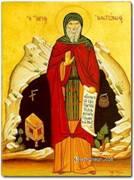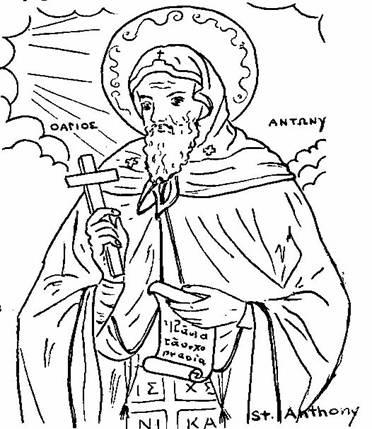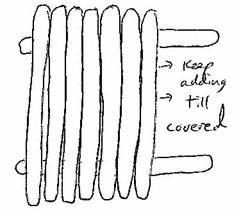Monasticism: St. Anthony the Great
MONASTICISM/ST. ANTHONY THE GREAT

Objectives:
- Students should be able to say the word “monasticism” and to know a little about the life of a monk.
- Students should be able to tell the story of St. Anthony.
- Students should know that St. Anthony is known as the father of monasticism.
Possible Lesson Plan:
- Open with prayer.
2. Tell the story of St. Anthony the Great:
About 250 years after the time of Jesus, a young man in Egypt named Anthony listened to the Gospel from Matthew 19:16-26. Reread it now. Anthony heard Jesus’s words to the rich young ruler. His parents had died; he cared for his younger sister. He was very rich. The words of Jesus spoke to Anthony. He sold his riches, found his sister a Christian home, and went off to the desert to live in a cave. There he spent his days and nights in prayer and Bible study. He ate little food – once every day or two or four. He had many battles with demons. He even got real bruises fighting them. Do you remember Jesus’s battle with the devil after His baptism? Finally, after many years, a light shone through the roof of the cave; from then on his pain was gone and so were the demons. Anthony thanked God for the strength He had given him.
He decided to go even farther from other men to be alone with God. He found an old fort on the banks of the Nile. He continued in fasting and prayer. Anthony thought he would never see another human being again. (Remember the story of Mary of Egypt?) But, after twenty years, other men began to seek out this holy hermit in the desert. They began to leave the cities to seek God alone; they became known as monks from the Greek word for alone. Each lived in a cave or grotto alone; only occasionally would they come together for prayer. Many came to Anthony to live near him and learn from his teachings and example. Because of this, Anthony is known as the Father of Monasticism.
As Anthony grew closer to God, people would come to him for prayer. A ruler in Egypt was healed of blindness; a girl who was paralyzed was healed. His wisdom was so well-known that Emperor Constantine the Great wrote to Anthony for advice. Anthony died in 356 AD. He asked the other monks to bury him secretly; they did, and his resting place is unknown to this day!
3. Discuss monastic life: What is a monk? How does a monk live? Some live alone as hermits or “anchorites” and some in communities called monasteries. St. Anthony had a group of other hermits living around him; another Egyptian named Pachomius began the first monastery where monks live in a large house and pray, study, and work together. St. Basil wrote the set of rules governing life in a monastery that is followed to this day. Ask the students what a typical day in their lives is like – what do they do, eat, wear, type of home, etc. Now take a monk in a monastery and contrast each aspect. Then a hermit. Quite a difference! There are famous monasteries to this day – St. Catherine’s Mt. Sinai (What happened here?) and many on Mt. Athos, an island off the coast of Greece. Would you want to be a monk (or nun)? Are you willing to give up everything for Jesus as Anthony did?
- Play a learning game: Try to sort these descriptions into the right type of monastic
life – hermitage or monastery or both:
Lives alone Lives in a group Follower of Pachomius
Fasts frequently Prays frequently Follows St. Basil’s rules
Works with other monks Eats with other monks Owns almost nothing
Lives in a cave Follower of St. Anthony Reads Bible frequently
- Make St. Anthony’s Empty Treasure Box: Take Popsicle sticks. Lay two on a plate, about 3 inches apart, and cover top surface with glue. Lay a row of perpendicular sticks across the two to make a smooth floor for the bottom of the box, the same way you did for the mosaic. Now glue 2 sticks parallel at the edge of the bottom. Put glue on the ends of these sticks and add 2 sticks perpendicular to the first two and parallel to each other at the other edges of the bottom. Keep adding until your box is the height you want. Can be spray painted. Or, make another bottom for a top. Glue a small icon of St. Anthony to the top. It’s empty now; St. Anthony owned nothing. What treasures will you put in it?
- Close with prayer: Lord, I ask St. Anthony to pray for me that I will grow closer to You every day.

